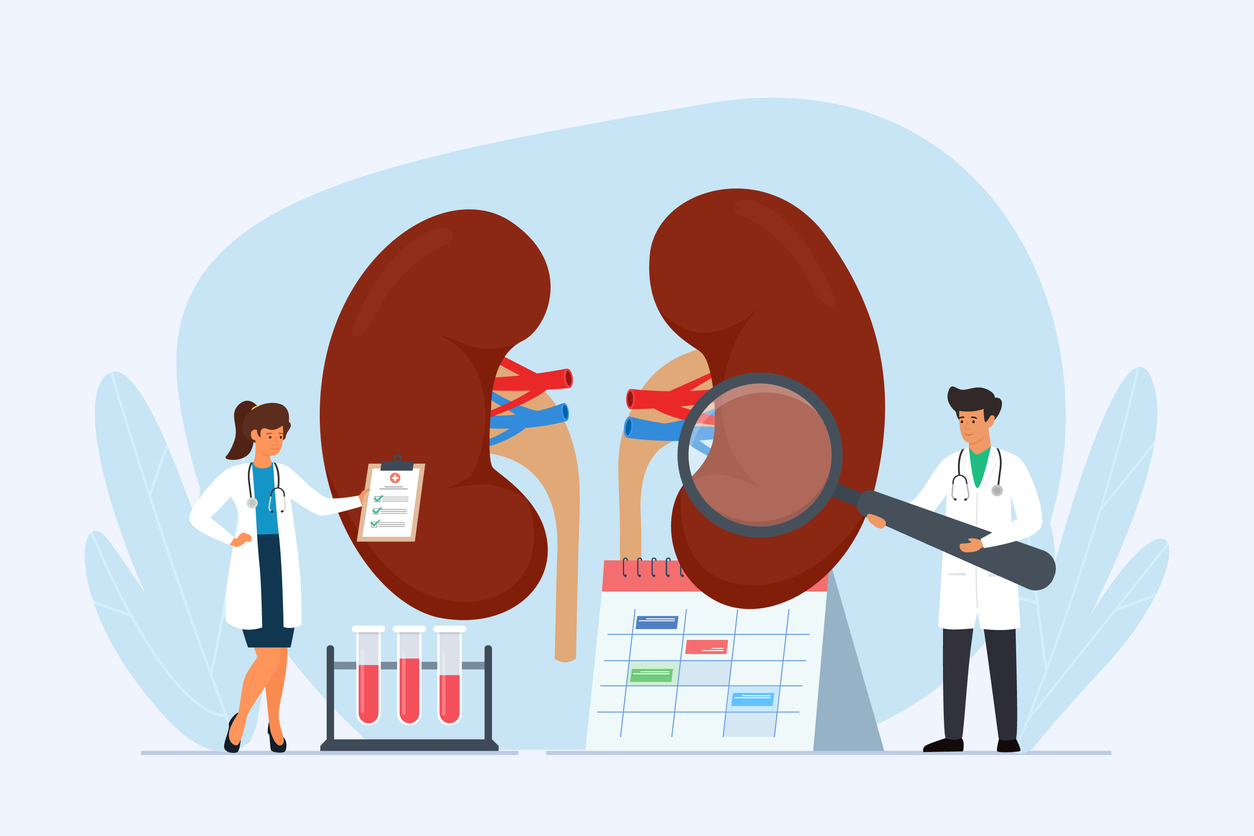Commitment + Clinical Leadership = Better Outcomes

Kidney Stones: Causes, Risks, and Symptoms
Kidney stones are very common, affecting more than 1 in every 10 people.1 More than half a million people visit the emergency room each year due to a kidney stone.2
Here are some facts about kidney stones, how they’re formed, symptoms to look out for, and what increases the risks of kidney stones.
What are Kidney Stones?
A kidney stone is a solid mass or crystal created by substances in your urine.3 These hard deposits typically consist of minerals and salts. When these minerals become concentrated in the urinary tract, they will stick together and form a kidney stone.4
A kidney stone can form in one or both of your kidneys. Kidney stones vary in size, and can be as small as a grain of sand to as large as a golf ball.5
Kidney stones can be in your kidneys for years without causing you any pain. The symptoms begin when the stone starts to move out of the kidney. A kidney stone can affect any part of your urinary tract, from the kidneys down to the bladder.
Types of Kidney Stones
There are a few different types of kidney stones.2
- Calcium oxalate – This is the most common type of kidney stone, and it’s formed with calcium combines when oxalate in the urine. Inadequate calcium or fluid intake can lead to this type of kidney stone.
- Uric acid – This is another common type, where high purine intake leads to a high production of monosodium urate, which creates a kidney stone. Purine is a natural chemical compound found in foods such as shellfish and organ meats.
- Struvite – This kind of kidney stone is less common and caused by an infection in the upper urinary tract.
- Cystine – This type of kidney stone is rare, but tends to run in families.
Causes of Kidney Stones
Different factors can increase your risk of kidney stones. Men are more likely to develop kidney stones than women. Kidney stones are also more common in people between the ages of 20 and 50.6
Here are some of the causes of kidney stones.3
- Dehydration
- Obesity
- Inflammatory bowel diseases
- A diet with high levels of protein or salt
- A family history of kidney stones
- A blockage in the urinary tract
- High blood pressure
- Diabetes
- Certain medications such as diuretics, some antibiotics, or those used to treat HIV and osteoporosis
Symptoms of Kidney Stones
You could have a kidney stone and not know it as long as it’s in your kidneys and not causing any pain. Symptoms will begin when a kidney stone starts to move or becomes large.
Some of the most common symptoms of a kidney stone include7:
- Pain in the lower back or side
- Nausea or vomiting
- Pain when urinating
- Blood when urinating
- Being unable to urinate
- Fever
Diagnosis and Treatment for Kidney Stones
Kidney stones are diagnosed using multiple tests. An X-ray can spot a kidney stone. However, a CT scan is considered the most efficient test to locate a kidney stone and show how large it is.8
The treatment options for a kidney stone will range depending on the type of stone, as well as the severity and duration of symptoms.
Many people may wait for the stone to pass on its own if it’s small enough and if the pain is bearable. Drinking plenty of water and taking pain medication is often advised.
In some cases, surgery may be needed for kidney stones, including9:
- It’s too painful
- It will not pass on its own
- It’s affecting kidney function
- The stone is blocking the flow of urine
- The stone is causing an infection
Does Your Risk for Kidney Stones Increase in the Summer?
Surprisingly, doctors see more patients with kidney stones during the summer months.
What causes the risk for kidney stones to be greater in the summer? There are a few explanations.10
- Your body may produce more calcium in the winter. 80% of kidney stones are calcium-based, and your body has been proven to produce more calcium in the winter, which increases your risk of a kidney stone forming. By the time summer comes around, it’s more likely to have grown or started moving.
- Dehydration. Dehydration is one of the primary causes of kidney stones. Many people get dehydrated in the summer more than other seasons because of the higher temperatures and outdoor activities.11
- You’re more active in the summer. Many people are less active in the winter, which can increase the risk of a kidney stone. Then, once summer comes around, temperatures increase and people can become dehydrated, which allows a kidney stone to grow and start to move.
Learn More
Take the time to learn more about kidney stones today and how you can reduce your risk. Make sure to stay hydrated, active, and eat a balanced diet this summer to lower your chance of a kidney stone.
Saber Healthcare is an organization dedicated to providing consultant services to long-term care providers. This article is for informational purposes and is not meant to be seen as professional advice. Please consult with a medical expert before relying on the information provided.
Sources
- https://www.nhs.uk/conditions/kidney-stones/#:~:text=Contents&text=Kidney%20stones%20can%20develop%20in,the%20kidneys%20to%20your%20bladder.
- https://www.kidney.org/atoz/content/kidneystones.
- https://my.clevelandclinic.org/health/diseases/15604-kidney-stones.
- https://www.mayoclinic.org/diseases-conditions/kidney-stones/symptoms-causes/syc-20355755#:~:text=Kidney%20stones%20(also%20called%20renal,many%20causes%20of%20kidney%20stones.
- https://www.niddk.nih.gov/health-information/urologic-diseases/kidney-stones.
- https://www.healthline.com/health/kidney-stones.
- https://www.healthline.com/health/symptoms-of-kidney-stones.
- https://www.kidneyfund.org/all-about-kidneys/other-kidney-problems/kidney-stones.
- https://www.urologyhealth.org/urology-a-z/k/kidney-stones.
- https://health.clevelandclinic.org/if-youre-in-pain-with-kidney-stones-it-must-be-summer/.
- https://www.premiermedicalhv.com/news/summer-is-kidney-stone-season/.
